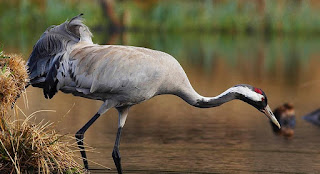Birds 🦆
Birds 🦆
There are multiple species of birds choosing wetlands as their habitat. The presence of water is linked to invertebrate, fish and plant populations which ensure stable food sources for birds. Hiding within the wetland vegetations can also be a very effective strategy for protection of the offspring from predators.
Here is a list of chosen bird species inhabiting Polish wetlands!
Male ruff during his mating display. Source.
Ruff (Calidris pugnax) - a migratory bird spending warm months of the year in Northern Eurasia. In Poland its population is decreasing dramatically and its population within the country is critically endangered due to the habitat loss. Ruff expresses strong sexual dimorphism with males being bigger and more colorful than females. In late March and early April, migrating males establish their territories which they aggresively protect. 2-3 weeks later, when females arrive on the mating grounds, males display for them by performing an impressive choreography of shaking their heads, showing their colorful feathers and tails. The species is under strict protection.
Aquatic warbler. Source.
Aquatic warbler (Acrocephalus paludicola) - a small migratory bird reaching up to 13cm in size with maximum wingspan of 19cm. Very picky when it comes to habitat - choosing only fertile wetlands with grassy vegetation, rich Carex populations and water depth not exceeding 15cm. It is under strict protection and is labelled as worldwidely endangered.
Eurasian crane. Source.
Eurasian crane (Grus grus) - a big migratory bird reaching up to 125cm in height with wingspan of even 200-240cm! Those birds build nests directly on the ground with their size reaching up to 80cm in diameter. They bond in pairs for life. Eurasian crane used to inhabit the entire Europe; due to habitat loss in Southern Europe its population towards the south from the Baltic Sea is not continuous and is broken up into subpopulations instead. It is under strict protection.


